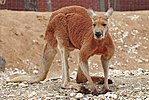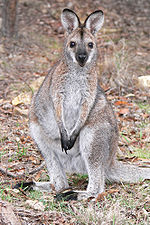The Macropodidae are an extant family of marsupial with the distinction of the ability to move bipedally on the hind legs, sometimes by jumping, as well... 8 KB (985 words) - 11:40, 12 March 2024 |
 | Tim Flannery (category Fellows of the Australian Academy of Science) fossil records of Phalangeridae and Macropodidae. While mammal curator at the Australian Museum, he undertook a survey of the mammals of Melanesia, where... 78 KB (7,390 words) - 02:42, 23 April 2024 |
 | Protemnodon (category Pliocene mammals of Australia) "A new genus of kangaroo (Marsupialia, Macropodidae) from the late Pleistocene of Papua New Guinea". Transactions of the Royal Society of South Australia... 6 KB (535 words) - 05:22, 22 April 2024 |
 | Marsupial (redirect from Evolution of marsupials) numbers. For instance, members of the Macropodidae family, including kangaroos and wallabies, have a dental formula of 3/1 – (0 or 1)/0 – 2/2 – 4/4. Many... 73 KB (7,557 words) - 15:10, 23 April 2024 |
 | Notamacropus (category Marsupials of Australia) Notamacropus is a genus of small marsupials in the family Macropodidae, commonly known as wallabies (among other species). The term is derived from the... 4 KB (271 words) - 06:26, 3 March 2024 |
 | Kangaroo (redirect from Sexual behavior of kangaroos) Kangaroos are marsupials from the family Macropodidae (macropods, meaning "large foot"). In common use the term is used to describe the largest species... 68 KB (7,441 words) - 13:20, 22 April 2024 |
 | Macropus (category Marsupials of Australia) Macropus is a marsupial genus in the family Macropodidae. It has two extant species of large terrestrial kangaroos. The term is derived from the Ancient... 5 KB (387 words) - 14:57, 20 January 2024 |
 | Bettong (category Marsupials of Australia) evidence supports specific recognition of the recently extinct Bettongia anhydra (Marsupialia: Macropodidae)". Journal of Mammalogy. 96 (2): 287–296. doi:10... 6 KB (571 words) - 18:00, 3 March 2024 |
 | Osphranter (category Marsupials of Australia) Osphranter is a genus of large marsupials in the family Macropodidae, commonly known as kangaroos and wallaroos (among other species). It contains the... 4 KB (289 words) - 16:59, 3 March 2024 |
Convergent evolution—the repeated evolution of similar traits in multiple lineages which all ancestrally lack the trait—is rife in nature, as illustrated... 137 KB (14,804 words) - 14:17, 19 April 2024 |
 | Tree-kangaroo (redirect from Evolution of tree-kangaroos) "Reproduction of Lumholtz's tree-kangaroo, Dendrolagus lumholtzi (Marsupialia : Macropodidae) in captivity, with age estimation and development of the pouch... 21 KB (2,141 words) - 02:59, 25 April 2024 |
 | osteology-based appraisal of the phylogeny and evolution of kangaroos and wallabies (Macropodidae: Marsupialia)". Zoological Journal of the Linnean Society... 7 KB (459 words) - 03:05, 25 April 2024 |
 | Quokka (category Endemic fauna of Southwest Australia) "Mortality and survivorship of the quokka (Setonix brachyurus)(Macropodidae: Marsupialia) in the northern jarrah forest of Western Australia" (PDF). Wildlife... 29 KB (3,034 words) - 03:05, 1 April 2024 |
 | Sugar glider (category Least concern biota of Oceania) flying squirrel, despite not being closely related—an example of convergent evolution. The scientific name, Petaurus breviceps, translates from Latin... 52 KB (5,838 words) - 11:11, 10 April 2024 |
 | Wondiwoi tree-kangaroo (category Marsupials of New Guinea) feed on plant matter. Tree-kangaroos belong to the macropod family (Macropodidae) with kangaroos, and carry their young in a pouch like most other marsupials... 11 KB (1,222 words) - 22:29, 3 March 2024 |
 | Australidelphia (category Marsupials of Australia) feather-tailed possum Family Hypsiprymnodontidae: musky rat-kangaroo Family Macropodidae: kangaroos, wallabies, and allies Family †Thylacoleonidae: marsupial... 10 KB (558 words) - 06:15, 10 April 2024 |
 | Sthenurus (category Prehistoric mammals of Australia) Sears, K. E. (2005). "Role of development in the evolution of the scapula of the giant sthenurine kangaroos (Macropodidae: Sthenurinae)". J. Morphol.... 15 KB (1,648 words) - 21:50, 14 November 2023 |
 | Bipedalism (redirect from Evolution of bipedalism in humans) 1988). "The Phylogenetic Position of the Musky Rat-Kangaroo and the Evolution of Bipedal Hopping in Kangaroos (Macropodidae: Diprotodontia)". Systematic Biology... 79 KB (9,473 words) - 15:54, 3 April 2024 |
rat-kangaroo as its only member; the Potoroidae, with 10 species; and the Macropodidae which had 53 members in Australia, but some species are extinct. The... 17 KB (2,116 words) - 18:02, 13 February 2024 |
 | Antilopine kangaroo (category Mammals of Western Australia) "Descriptions of four New Species of Kangaroos". Proceedings of the Zoological Society of London. 1841: 80. "Names List for MACROPODIDAE, Australian Faunal... 11 KB (1,315 words) - 17:18, 12 March 2024 |
 | Procoptodon (category Pleistocene mammals of Australia) ISBN 9780520916050. Haaramo, M. (2004-12-20). "Mikko's Phylogeny Archive: Macropodidae - kenguroos". Archived from the original on 2007-03-31. Retrieved 2007-03-15... 20 KB (2,027 words) - 03:32, 24 April 2024 |
 | Petauridae (section Evolution) similarities to the unrelated flying squirrels are an example of convergent evolution. The striped possums, on the other hand, are thought to have evolved... 4 KB (471 words) - 16:03, 14 October 2023 |
affinity of 'Silvaroo' buloloensis (Marsupialia, Macropodidae) from the late Pliocene of Papua New Guinea". Alcheringa: An Australasian Journal of Palaeontology:... 132 KB (13,779 words) - 19:56, 26 April 2024 |
 | Red kangaroo (redirect from Sexual behavior of red kangaroos) of kangaroos (Marsupialia-Macropodidae)". Mammal Review. 4 (1‐2): 1–59. doi:10.1111/j.1365-2907.1974.tb00347.x. Serventy, Vincent (1985). Wildlife of... 29 KB (3,215 words) - 14:39, 6 March 2024 |
 | Koala (redirect from Breeding behavior of koalas) anatomy of Oligo-Miocene koalas (Diprotodontia: Phascolarctidae): Stages in the evolution of an extreme leaf-eating specialization". Journal of Vertebrate... 88 KB (9,539 words) - 22:18, 22 April 2024 |




